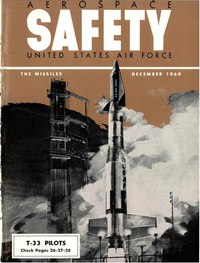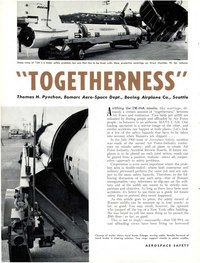Nonfiction
| Date | Title | Genre | Publication | Publisher | Notes | Ref. |
|---|---|---|---|---|---|---|
| Dec 1960 | Autobiographical Sketch/Proposal to the Ford Foundation | Proposal | Proposal for Ford Foundation Fellowship | Unpublished | Part of an unsuccessful proposal for a Ford Foundation fellowship, likely written in June or July 1959. In 1989 a Foundation archivist made this document available to several researchers, including Steven Weisenburger, who describes (but does not quote from) it. Late in 1989, at Pynchon's request, the Ford Foundation closed the author's file for the next 50 years, making this manuscript generally unavailable until 2039. | [30] |
| Dec 1960 | | Technical writing | Aerospace SafetyVol. 16, No. 12 | United States Air Force | Written during Pynchon's employment at Boeing. The byline gives his name as "Thomas H. [ sic ] Pynchon", which is considered an error. [31] Pynchon's middle name is "Ruggles". [32] | [33] |
| 1960– 1962 | [Various uncredited articles] | Technical writing | Bomarc Service News | Boeing | See section below . | [34] |
| Dec 1965 | "A Gift of Books" | Review | Holiday Vol. 38, No. 6 | Curtis Publishing Company | Review of the 1958 Western novel Warlock by American author Oakley Hall (1920–2008). [35] | [21] |
| Jun 12, 1966 | "A Journey into the Mind of Watts" | Essay | The New York Times Magazine | The New York Times | Essay on the Watts riots of August 11–16, 1965, and their aftermath in the neighborhood of Watts, Los Angeles, California. [36] | [37] |
| 1983 | Introduction to Been Down So Long It Looks Like Up to Me | Foreword | Been Down So Long It Looks Like Up to Me (3rd ed.) | Penguin Books | Introduction to the 1966 novel by American author Richard Fariña (1937–1966), who had been Pynchon's friend and schoolmate at Cornell. | [38] |
| 1984 | Introduction to Slow Learner | Preface | Slow Learner (1st ed.) | Little, Brown | An introduction to the collection of Pynchon's own early, previously published short stories. [8] In the 20-page preface, Pynchon reflects on the development of his writing, with autobiographical details that have made it a rare source of information about his life. [39] Though almost universally accepted as a work of nonfiction, the introduction has also been scrutinized as if it were a short story or a genre-ambiguous piece that may include elements of fiction. [40] | [41] |
| Oct 28, 1984 | "Is It O.K. to Be a Luddite?" | Essay | The New York Times Book Review | The New York Times | Essay advocating for neo-Luddism. [42] | [38] |
| Apr 10, 1988 | "The Heart's Eternal Vow" | Review | The New York Times Book Review | The New York Times | Review of the 1988 English-language translation of the novel Love in the Time of Cholera by Colombian author Gabriel García Márquez (1927–2014). | [38] |
| 1992 | Introduction to The Teachings of Don B. | Foreword | The Teachings of Don B. (1st ed.) | Turtle Bay | Introduction to a collection of writings by American author Donald Barthelme (1931–1989) edited by Kim Herzinger. | [41] |
| Jun 6, 1993 | "Nearer, My Couch, to Thee" | Essay | The New York Times Book Review | The New York Times | Essay on sloth in America. First entry in a summer-long series about the seven deadly sins by Pynchon, Mary Gordon, John Updike, William Trevor, Gore Vidal, Richard Howard and A. S. Byatt. These, along with an eighth essay by Joyce Carol Oates, became the book Deadly Sins ( ISBN 9780688136901). | [41] |
| Apr 1994 | Spiked! The Music of Spike Jones | Liner notes | Spiked! The Music of Spike Jones (CD compilation album) | Catalyst/BMG | Essay introducing the music of American bandleader Spike Jones (1911–1965), known for his satirical swing compositions and complex novelty arrangements. | [43] |
| Mar 1996 [note 5] | Nobody's Cool | Liner notes | Nobody's Cool (studio album) by Lotion | SpinART Records | Essay introducing the album by the American alternative rock band Lotion. | [41] |
| Jun 1996 | "Lunch with Lotion" | Interview | Esquire Vol. 125, No. 6 | Hearst Communications | Pynchon interviews the members of American alternative rock band Lotion. | [46] |
| 1997 | Introduction to Stone Junction | Foreword | Stone Junction: An Alchemical Potboiler (1st. pbk. ed.) | Rebel Inc. (Edinburgh) | Introduction to the first UK paperback edition of the 1990 novel by American author Jim Dodge (1945–). Pynchon had written a blurb for the dust jacket of the novel's hardcover first edition. [47] The following year, a US paperback edition with Pynchon's introduction was published by Grove Press (New York). [48] | [49] |
| Jan 1999 | "Hallowe'en? Over Already?" | Essay | Cathedral School Newsletter | The Cathedral School of St. John the Divine, Manhattan | Written when Pynchon's son, Jackson, was a second-grade student at the Cathedral School. The essay describes activities at the school during the fall of 1998, including a guided tour of the Cathedral of St. John the Divine. [50] | [41] |
| 2003 | Introduction to Nineteen Eighty-Four | Foreword | Nineteen Eighty-Four (Centennial Edition) | Plume | Introduction to a new edition of the 1949 novel by English author George Orwell (1903–1950) marking the centenary of Orwell's birth. The edition also includes a 1961 afterword by German-American writer Erich Fromm (1900–1980). | [51] |
| Nov 16, 2006 | "The Evolution of The Daily Show " | Essay | The Daily Show: Ten Fu@#ing Years (The Concert) | Irving Plaza (New York) | Essay for the program of The Daily Show's Ten-Year Anniversary Concert at Irving Plaza on November 16, 2006. | [41] |
Technical writing for Boeing
Between February 22, 1960 and to September 13, 1962, Pynchon was employed as a technical writer for the corporation Boeing, a major aerospace manufacturer and defense contractor. [52] During that time, only one technical article with Pynchon's byline appeared in print: the feature "Togetherness" in Aerospace Safety, a periodical published by the US Air Force rather than Boeing. While "Togetherness" is the only technical article that can be attributed to Pynchon with absolute certainty, it is considered extremely unlikely that he would have produced only one article during more than two years on the job. [53] As such, scholars have conducted research to identify articles that can plausibly be attributed to Pynchon.
Pynchon is known to have worked primarily as a staff writer for Boeing's Bomarc Service News, an in-house periodical related to development of the CIM-10 Bomarc surface-to-air missile. [note 6] It remains possible, albeit uncertain and unlikely, that Pynchon contributed to other publications as part of his work at Boeing. [note 7] Definitive attribution of any Bomarc Service News articles to Pynchon is impossible because the publication never used bylines. Nonetheless, at least two scholars have used textual analysis in an attempt to identify likely Pynchon pieces:
- In a 2000 article for Pynchon Notes, Adrian Wisnicki compiled a list of 24 "probable" and 10 "possible" examples of Pynchon's writing in Bomarc Service News based on stylistic and thematic similarities to known works. [59]
- In a 2019 article in the journal Textual Practice , Katie Muth used a stylometry-based authorship algorithm to identify eight Bomarc Service articles that were "closely correlated" with Pynchon's contemporaneous writing, as well as four that she determined were not correlated. [60] Muth later claimed that, from the "handful" of Bomarc articles that could be reasonably attributed to Pynchon, two were "particularly" likely matches: "Torquing" (June 1960) and "The Mad Hatter and the Mercury Wetted Relays" (February 1962). [61]
The following are Bomarc Service News articles assessed as potential Pynchon articles by Wisnicki, Muth, or both.
| Date | Title | Probability of Pynchon's authorship, according to... | Ref. | |
|---|---|---|---|---|
| Wisnicki 2000–2001 | Muth 2019a/2019b | |||
| Mar 1960 | "Vibration Testing" | Probable | "Closely correlated" | [62] |
| Apr 1960 | "Weight Control" | Probable | N/A | [63] |
| May 1960 | "Missile Mockups" | Probable | N/A | [63] |
| Jun 1960 | "Torquing" | Probable | "Closely correlated" + "particularly" likely | [64] |
| Jul 1960 | "SCE Calibration" | Probable | N/A | [63] |
| Sep 1960 | "Package Handling" | Probable | N/A | [63] |
| Oct 1960 | "Analog Simulations" | Probable | Not correlated | [65] |
| Oct 1960 | "ANFA Hazard" | Probable | N/A | [66] |
| Nov 1960 | "1,000,000,000 = One Gigamile" | Probable | N/A | [66] |
| Nov 1960 | "Telemetering: Recovery, Recording, Reduction" | Possible | Not correlated | [67] |
| Dec 1960 | "Missile Sealants" | Possible | N/A | [68] |
| Jan 1961 | "Blame It on Osmosis" | Possible | N/A | [68] |
| Mar 1961 | "Separation Diaphragms" | Probable | N/A | [66] |
| Apr 1961 | "Maintainability, Part 2" | Probable | Not correlated | [69] |
| Jun 1961 | "Maintainability, Part 3" | Probable | N/A | [66] |
| Jul 1961 | "Of Astronauts and Acid" | Possible | N/A | [68] |
| Jul 1961 | "Records Prove Valuable" | Possible | N/A | [68] |
| Aug 1961 | "Soldering" | Probable | "Closely correlated" | [70] |
| Sep 1961 | "Maintainability, Part 4" | Probable | N/A | [71] |
| Oct 1961 | "Transporter-Loader Hoist Safety" | Possible | N/A | [68] |
| Jan 1962 | "Attention to Detail" | Probable | N/A | [71] |
| Jan 1962 | "IM-99B Flyaway Kits" | Possible | N/A | [68] |
| Feb 1962 | "'Teflon' in Depth" | Probable | Not correlated | [70] |
| Feb 1962 | "The Mad Hatter and the Mercury Wetted Relays" | Probable | "Closely correlated" + "particularly" likely | [72] |
| Mar 1962 | "A Blinding Flash" | Possible | N/A | [68] |
| Mar 1962 | "Vent Those Tanks!" | Possible | N/A | [68] |
| Apr 1962 | "MIU Plug Problems" | Probable | "Closely correlated" | [67] |
| Jul 1962 | "Environmental Protection" | Probable | "Closely correlated" | [67] |
| Aug 1962 | "The Trouble with Safety Is... People!" | Probable | "Closely correlated" | [67] |
| Sep 1962 | "Hydrazine Tank Cartridge Replacement" | Probable | "Closely correlated" | [67] |
| Oct 1962 | "Bomarc Reliability and You" | Probable | N/A | [73] |
| Oct 1962 | "Safety Devices?" | Possible | N/A | [68] |

